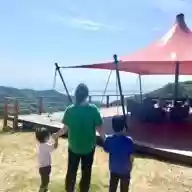[Warabe-uta] Beloved Classic Songs Passed Down Through Generations
Nursery rhymes that have been passed down in Japan since long ago.
There are many types of nursery rhymes, including drawing songs, counting songs, and play songs.
Many of you probably sang and played games like Kagome Kagome and Hana Ichi Monme at least once when you were children.
In this article, we introduce popular nursery rhymes.
If you want to remember the nursery rhymes you sang as a child or enjoy them with your kids, be sure to give them a listen!
[Warabe-uta] Beloved Nostalgic Classics Passed Down in Song (1–10)
Goodbye, ankoro mochi.

A playful wordplay centered on the traditional Japanese sweets “ankoro mochi” and “kinako,” imbued with the wish to meet again, leaves a strong impression.
By singing with hand games and gestures, it nurtures children’s creativity and communication skills.
In nursery schools and kindergartens, puppets are often used to perform it so that children can enjoy their farewell time.
Passed down for many years as a traditional song, this piece has been included in numerous childcare-related books and CDs as a teaching material that supports children’s emotional development.
It’s also a recommended song for parents and children to enjoy singing together while experiencing Japan’s traditional culture.
One, two, three, four, two, five

This traditional children’s song, beloved across generations, features a simple way to play: sing rhythmic number phrases while raising and bending your fingers.
It has been featured on NHK’s children’s program Nihongo de Asobo and is popular on video-sharing sites.
The piece has been carried forward in new forms by contemporary artists such as dmg’s “Ichi Ni San Shi” and Gen Hoshino’s “Ichi Ni San.” It’s a fun song you can enjoy with parents or friends while nurturing finger dexterity and a sense of rhythm.
oshikura manju (a children’s pushing game)

This song is charming for its friendly melody and playful lyrics that use the image of manju buns.
Born from the wisdom of keeping warm, it has been passed down across generations as a game that shares warmth and smiles.
Beyond its value as a play song, it is deeply rooted in Japanese culture, even appearing in haiku as a winter season word.
On a cold winter day, if you sing it while actually doing oshikura manju—huddling and gently pushing each other—children will surely feel not only the warmth of skin, but also the joy of time spent with friends and family.
Pretty good.children’s song

This is a delightful piece that rhythmically combines movements of the hands and feet with singing.
If you move your hands and feet to the rhythm created by the call-and-response of “naka” (inside) and “soto” (outside), both body and heart naturally start to bounce.
Playing in a circle fosters children’s cooperation and sense of unity, spreading smiles—one of the work’s key charms.
It has long been loved in nurseries and kindergartens across ages, and in April 2020 it was selected for the “Top 100 Traditional Play Activities” by the Japan National Association of Nursery Teachers.
It’s a highly recommended song for those who want to interact with children and enjoy rhythm play.
Oonami Konami

Positioned as a staple song for long-rope jumping and Eurhythmics, this piece is enjoyed along with movements that express the motion of waves by swinging the rope widely from side to side.
By moving their bodies while singing, children naturally develop a sense of rhythm and cooperation.
It is also used in settings for children’s music education and emotional development, and is included in Kyoiku Geijutsusha’s elementary school music textbook “Ongaku for Elementary Students 1.” Many people may remember happily doing group long-rope jumping to this tune while humming it as children.
The lyrics seem to vary by region, so if you’re curious, be sure to check them out.
Keep crossing the bridge one after another.

A song with simple lyrics and a rhythmic melody, sprinkled with elements that spark excitement and imagination as a fox appears.
It is included in many nursery rhyme collections, and picture books based on this song have also been published.
This piece is used for group play in kindergartens and nursery schools, where activities like holding hands to pass through a gate or cross a bridge help foster children’s cooperation and sense of rhythm.
Please experience this heartwarming song that you can sing and play together with someone special.
Churippu sharippuchildren’s song

A simple yet profound traditional children’s song.
The part where everyone stands in a circle and calls each other’s names is perfect for fostering communication skills and social development.
Its rhythmic lyrics and melody are fun and easy to learn.
In nursery schools and kindergartens, it’s often used to help ease the nerves of new children.
At home, singing and playing it together as a family is sure to create joyful moments from infancy onward.
When the spring weather invites you outside, why not gather in a circle and sing it together?





![[Warabe-uta] Beloved Classic Songs Passed Down Through Generations](https://i.ytimg.com/vi_webp/iRlAnMUgT14/maxresdefault.webp)

